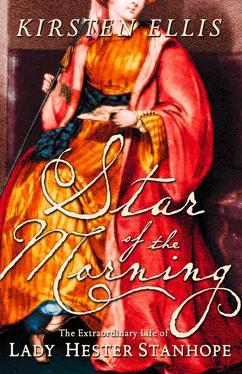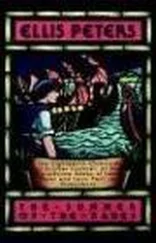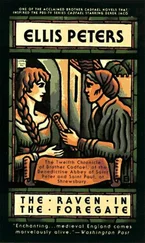Moore was slight and handsome with a moustache and sidewhiskers which he kept neatly clipped, but which nonetheless he worried at constantly with his fingers when under strain, as he did now. For this event, he had been careful to wear a black armband and dress in sombre colours with a high stiff collar. ‘It was an intensely hot Sabbath,’ Thomson would record. The idea of a woman’s corpse lying here for over a day in such unbearable warmth made him nauseous. Sweat dripped from his temples and soaked his jacket. He did not wish to investigate further.
Behind the men, a small tribe of servants had assembled. Decisive action was required. There had been thirty-seven servants in the fortress in the morning. They had watched ‘every motion of her eye’ until she died. Most had taken what they could and fled. Now, some ten or so remained. Moore noticed that many of the servants seemed to be wearing what he surmised to be cast-off robes and hats from the wardrobe of their mistress. As his eyes adjusted to the gloom, he saw that their ragged clothes were incongruously matched with brilliant velvet and brocade cloaks, red turbans, silk stockings and carpet slippers.
By midnight the men had ascertained several facts. Although she had left no written instructions, it was clear that Lady Hester had managed to convey how she wished to be buried. At least five of her servants professed to be expert on the subject, and one in particular had apparently been entrusted with duties he had sworn on his life to carry out. This was her most trusted servant, Almaz – her dragoman – who combined the roles of translator, secretary, gardener and general factotum.
They decided to do as she had apparently asked. Lady Hester was to be buried in a grave at a specified place in her garden, which already contained a vault, along with the bones of a Frenchman by the name of Loustaunau, who had been buried there before. ‘The vault in the garden was hastily opened and the bones of General Loustaneau [ sic ], or of his son, I forget which – a Frenchman who died here … were taken out’ and readied for burial. 3 How he had died and why Her Ladyship commanded this posthumous mingling, which Moore regarded as immoral, it was difficult to say. Such an indelicate request on the part of this spinster might be best left out of his report. 4 He would have to decide whether or not it would be necessary to mention this detail when he informed the ladyship’s younger brother. A more chaste companion had been intended for the burial ceremony: the jaunty square of the Union Jack flag which he had brought for the purpose, folded away in his saddlebag. A roll of white muslin would do as a shroud. The vault would be opened and its contents were to be arranged according to Lady Hester’s instructions. Reverend Thomson would perform the Church of England service. 5
Despite the heat and disrepair, the garden impressed the men. Thomson would later describe it as ‘a wilderness of shady avenues, and a paradise of sweet flowers … I have rarely seen a more beautiful place’. They left the dragoman to open the vault and arrange its contents according to the instructions Lady Hester had given him and returned to supervise the removal of the body into its waiting shroud, and its placement into the plain wooden coffin they had brought with them from Djoun. The carved staff was clasped between her hands. After draping the Union Jack over the open coffin, they followed the procession of her servants bearing her aloft, threading their way through the passageways and out to the garden. Thomson wrote of the macabre sight awaiting them: ‘When at length I enterered the arbour, the first thing I saw were the bones of the general, in a ghastly heap, with the head on top, having a lighted taper stuck in either eye-socket – a hideous, grinning spectacle.’ 6 The servants were clearly no less taken aback. They stood aside, respectfully, as though this arrangement had a dignity of its own. Moore stared in shock at the open vault for some moments. There was nothing to be done except to conduct the funeral as rapidly as possible.
The next morning, after a rough night, overhearing shouting between the squabbling servants, who were anxious about their unpaid wages, the men went around the premises to make an inventory of Lady Hester’s assets. They had not been the first to inspect her Djoun fortress, for as soon as news of her death had reached Sidon, the British consul there, a wealthy Maltese Jew by the name of Joseph Abela, had immediately hurried up in order to prevent her house from being ransacked. Abela had ordered the more valuable-looking furniture and possessions to be piled up together in rooms which he had sealed up.
They counted thirty-five rooms, not including the cellars or the stables. Thick curtains were draped across the windows, but the light was just bright enough to see tables, chairs and chests, all inlaid with mother of pearl; cushions in Aleppo silk and bright woven carpets; bolts of calico, brocade and linen; large brass lanterns, damascene glass and brassware; and carved, painted wooden doors off their hinges, rich in geometric star patterns. There were stained-glass windows, blue and white Mameluke jars, and large circular pewter trays. One room contained countless letters, some filed, some heaped at random, and papers of esoterica scrawled with strange diagrams and notes in a language Moore surmised to be Hebraic, as well as boxes of books. Another was filled with more than forty oil jars, but they were all empty, and spiders nested between them; in still another, there were enough Arab saddles for a small army. Two more were crammed with medicines – a madwoman’s pharmacopoeia of phials, pills and powders, with medical almanacs and instruments of all descriptions. A store-room contained shelves of stacked boxes, some of whose contents were emptied out: cases of Promethean matches, silver snuff boxes, a few prized canisters of tea and jam from Jermyn Street, candles, Epsom salts, watercolours of English soldiers on horseback, a portrait of the Duke of York, green umbrellas and English gunpowder. There were a great many narguileh and tchiboque pipes. They speculated as to how many of the ladyship’s most valuable possessions had been stolen the previous day.
When Moore opened the closet in what he assumed to be Lady Hester’s dressing room, out spilled models cut in paper of rooms with arches, vaults and pavilions and buildings, and fountains, all scrawled with her comments in the margins. Gradients, plans for borders and paths and notes for unusual trees and shrubs. He found himself admiring the determination of this singular woman, cutting out shapes with her scissors, studying books – designing, building and furnishing her mansion of dreams – so far from home.
She came into the world with a shock of chestnut hair and bright, greyish-blue eyes, blinking at the watery sunshine that came slanting in through frosted windowpanes. It was Tuesday, 12 March 1776, a clear, chill day in London. That morning, Handel’s Messiah was being rehearsed at the Theatre Royal in Covent Garden; a short distance away in Hanover Square, J. C. Bach was preparing for his performance the following evening.
It had been one of the coldest winters on record; the Thames had frozen over, and the city was blanketed by great drifts of snow. At the first hint of the child’s arrival, Lord Mahon, Charles Stanhope (the future third Earl Stanhope), sent urgently for a trusted doctor. By the standards of the day it was considered an easy delivery.
Instructed to remain completely supine for at least a week before attempting to sit up and not to leave their Marylebone townhouse on Queen Anne Street for another month (a ruling she would soon ignore) the new mother contemplated her daughter, now bathed and dressed in a flannel gown and cap. She was a healthy size, with an equally healthy pair of lungs. She was to be called Hester, after her mother.
Читать дальше












